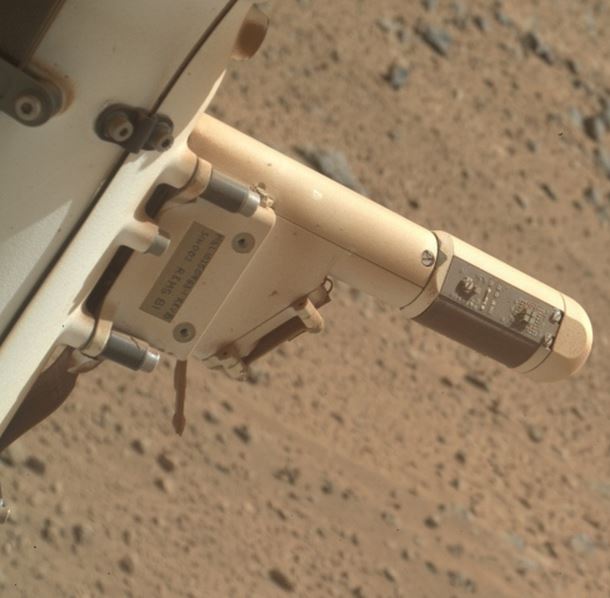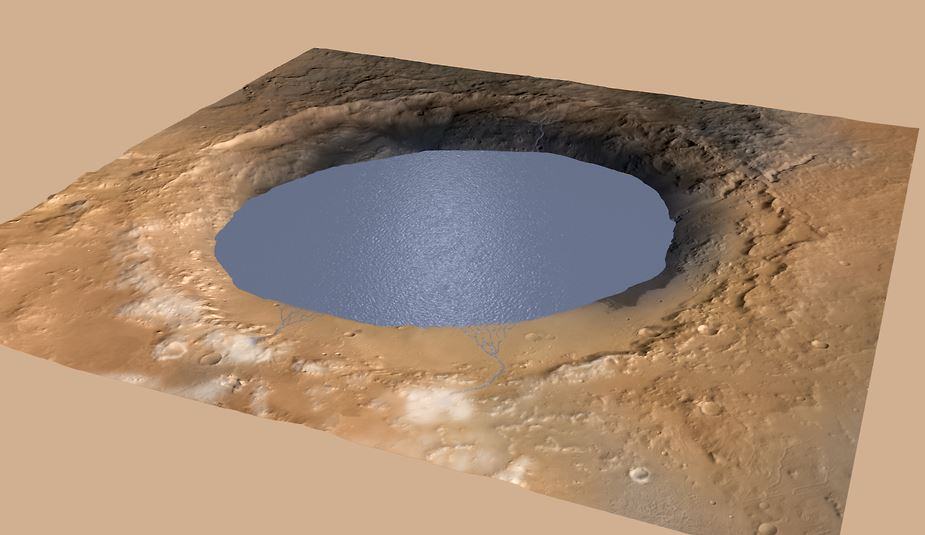While the surface of Mars is too cold for liquid water, it probably exists just below, according to data gathered by NASA’s Curiosity rover. There are salts in the Martian soil that lower water’s freezing point, which allow briny films to form, scientists informed.
NASA scientists explained in the journal Nature Geoscience that thin films of water are formed when perchlorates (salts) in the soil absorb water vapour from the air.
It is highly unlikely these liquid films, which are super-cold (about -70°C), could support any kind of life as we know it, they added.

The meteorological station REMS onboard the Marsrover Curiosity. (Image: NASA/JPL-Caltech)
The brines, which form in the top 15cm layer of the Martian soil, are also exposed to extremely high levels of cosmic radiation, which further reduce the likelihood of any microbial life forms being able to exist.
However, deeper down below the surface, conditions might be less inhospitable.
Mars has a water cycle
NASA scientists gathered various data from Curiosity rover’s suite of scientific instruments. Its weather station, called REMS (Rover Environmental Monitoring System), measured the relative temperature and humidity at its landing site of Gale Crater (which was probably once a lake, see picture below).
According to data gathered from a scientific instrument called DAN (Dynamic Albedo of Neutrons), the team was able to estimate concentrations of water just below Mars’ surface. They found that the water in the Martian soil was bound to perchlorates.
Another instrument – SAM (Sample Analysis at Mars) – provided data on water concentrations in the atmosphere.
The scientists calculated that conditions were ideal for the brines to form at the Red Planet’s equator during the winter nights, but would rapidly evaporate as soon as the Sun came up in the morning.
Lead author, Professor Javier Martín-Torres, who works at Luleå University of Technology in Sweden, and is also a member of Curiosity’s science team and the Spanish Research Council, explained to the BBC that the detection was indirect but compelling.

This illustration depicts a lake of water partially filling Mars’ Gale Crater. Scientists believe it had water a long time ago. (Image: NASA)
Prof. Martín-Torres said:
“What we see are the conditions for the formation of brines on the surface. It’s similar to when people were discovering the first exoplanets. They were not seeing the planets, but they were able to see the gravitational effects on the star.”
“These perchlorate salts have a property called deliquescence. They take the water vapour from the atmosphere and absorb it to produce the brines. We see a daily water cycle – which is very important. This cycle is maintained by the brine. On Earth we have an exchange between the atmosphere and the ground through rain. But we don’t have this on Mars.”
In Mars brines form in colder temperatures
In Mars’ case, the formation of brines occurs in colder temperatures. The fact that evidence of these brines was found at the equator, where scientists say conditions are least favourable, they are probably more abundant at higher latitudes (further away from the equator), where temperatures are lower and humidity is higher.
Co-author, HiRISE Principal Investigator, Alfred McEwen, who works at the University of Arizona, Tucson, said:
“Gale Crater is one of the least likely places on Mars to have conditions for brines to form, compared to sites at higher latitudes or with more shading. So if brines can exist there, that strengthens the case they could form and persist even longer at many other locations, perhaps enough to explain RSL activity.”
Prof. Martín-Torres and colleagues believe that at higher latitudes, brine just below the surface could be present throughout the year.
Co-author, Curiosity Project Scientist Ashwin Vasavada, who works at NASA’s Jet Propulsion Laboratory, Pasadena, California, said:
“We have not detected brines, but calculating the possibility that they might exist in Gale Crater during some nights testifies to the value of the round-the-clock and year-round measurements REMS is providing.”
According to Curiosity’s measurement, relative humidity in Mars ranges from 100% in winter and autumn nights to about 5% on summer afternoons.
Reference: F. Javier Martín-Torres, David Vaniman, María-Paz Zorzano, Patricia Valentín-Serrano, Pamela Conrad, Ari-Matti Harri, Maria Genzer, Dawn Sumner, Osku Kemppinen, Edgard G. Rivera-Valentin, Ashwin R. Vasavada, Insoo Jun, James Wray, Morten Bo Madsen, Walter Goetz, Gilles Berger, Alfred S. McEwen, Charles Cockell, Craig Hardgrove, Tim McConnochie, Nilton Renno, Vincent F. Chevrier, Jesús Martínez-Frías, Michael Mischna, and Rafael Navarro-González. “Transient liquid water and water activity at Gale crater on Mars.” Nature Geoscience. Published. Published 13 April, 2015. DOI: 10.1038/ngeo2412.
